Section 1: Agency overview and resources
1.1 Strategic direction
The Productivity Commission (the Commission) is the Australian Government's independent research and advisory body on a range of economic, social and environmental issues affecting the welfare of Australians. The Commission's work extends to the public and private sectors, including areas of State, Territory and local government, as well as federal responsibility.
As a review and advisory body, the Commission does not have responsibility for implementing Government programs. It carries out inquiry, research, advising and incidental functions prescribed under the Productivity Commission Act 1998.
The Commission contributes to well-informed policy decision-making and public understanding on matters relating to Australia's productivity and living standards, based on independent and transparent analysis that takes a community-wide perspective rather than just the interest of particular industries or groups. The Commission has four broad components of work:
- government commissioned projects;
- performance reporting and other services to government bodies;
- competitive neutrality complaints activities; and
- supporting research and activities and statutory annual reporting.
It is anticipated the Commission's work in 2011-12 and the forward years will be integral to the national reform agenda. The Commission will continue to examine a variety of economic, social and environmental issues through its public inquiry and commissioned research program. Commissioned projects currently underway and carrying over into 2011-12 include: inquiries into Disability Care and Support, Australia's Urban Water Sector, Economic Regulation of Airport Services, Economic Structure and Performance of the Australian Retail Industry; studies of the Education and Training Workforce — Early Childhood Development, and Schools; and a continuation of the stream of work dealing with Performance Benchmarking of Australian Business Regulation and Review of Regulatory Burdens on Business.
Several of the commissioned projects have been initiated by the Council of Australian Governments (COAG). The Commission is also working with Australia's jurisdictions in respect of standing research responsibilities and specific projects. In particular, the Commission is providing cross-jurisdictional reporting to COAG on performance of government services; indicators of Indigenous disadvantage; and expenditure on services to Indigenous Australians. The Commission prepares and reports performance information to the COAG Reform Council in respect of the Intergovernmental Agreement on Federal Financial Relations. The Commission is also undertaking data development, modelling and analysis to report on the economic impacts and benefits of COAG's agreed reform agenda.
The Australian Government Competitive Neutrality Complaints Office (AGCNCO) is an autonomous office located within the Commission. Its function is to receive and investigate complaints and provide advice to the Assistant Treasurer on the application of competitive neutrality arrangements. AGCNCO also provides informal advice on, and assists agencies in, implementing competitive neutrality requirements.
The Commission has a statutory mandate to undertake research to complement its other activities. The supporting research program includes work on productivity performance and its determinants, environmental and resources management, labour markets (including social dimensions) and development of economic models and frameworks. The Commission's most recent research reports and staff working papers released in 2010-11 include Population and Migration — Understanding the Numbers, Labour Force Participation of Women Over 45, and Childhood Obesity — An Economic Perspective. A full list of the Commission's research reports and staff working papers is provided on the Commission's website.
1.2 Agency resource statement
Table 1.1 shows the total resources from all sources. The table summarises how resources will be applied by outcome and by departmental classification.
Table 1.1: Productivity Commission resource statement — Budget estimates
for 2011-12 as at Budget May 2011
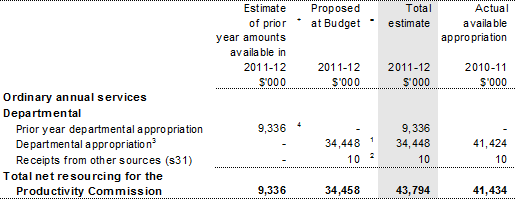
1. Appropriation Bill (No. 1) 2011-12.
2. Receipts received under s31 of the Financial Management and Accountability Act 1997.
3. Includes $0.34 million in 2011-12 for the departmental capital budget (also refer to Table 3.2.5).
4. Estimated adjusted balance carried from previous year for annual appropriations.
1.3 Budget measures
Budget measures relating to the Commission are detailed in Budget Paper No. 2, Budget Measures 2011-12 and are summarised below.
Table 1.2: Productivity Commission 2011-12 Budget measures
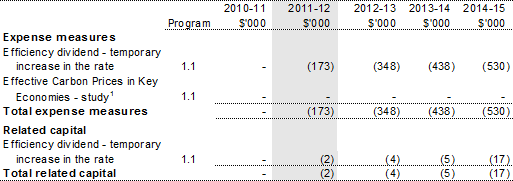
1. The Commission received $2.643 million in 2010-11 for this measure in the 2010-11 Additional Estimates.
Prepared on a government finance statistics (fiscal) basis.
Section 2: Outcomes and planned performance
2.1 Outcomes and performance information
Government outcomes are the intended results, impacts or consequences of actions by the Government on the Australian community. Commonwealth programs are the primary vehicle by which government agencies achieve the intended results of their outcome statements. Agencies are required to identify the programs which contribute to Government outcomes over the budget and forward years.
The Commission's outcome is described below, specifying the strategy, program, objective, deliverables and key performance indicators used to assess and monitor the performance of the Commission.
Outcome 1: Well-informed policy decision-making and public understanding on matters relating to Australia's productivity and living standards, based on independent and transparent analysis from a community-wide perspective
Outcome 1 strategy
The Commission's activities derive from its statutory functions outlined in the Productivity Commission Act 1998 and reported in detail in the Annual Report. The Commission aims to demonstrate its effectiveness by reporting annually on the relevance, quality, timeliness and cost-effectiveness of its activities.
Outcome expense statement
Table 2.1 provides an overview of the total expenses for Outcome 1.
Table 2.1: Budgeted expenses for Outcome 1
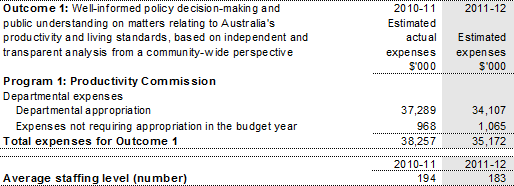
Contributions to Outcome 1
Program 1.1: Productivity Commission
Program objective
The Commission's objective is to contribute to well-informed policy decision-making and public understanding on matters relating to Australia's productivity and living standards, based on independent and transparent analysis from a community-wide perspective.
Program expenses
The decrease in expenses from 2010-11 is primarily due to ceasing funding for the study into emission reduction policies in key economies received in the 2010-11 Additional Estimates.
Table 2.2: Program expenses

Program deliverables
The Commission will deliver:
- public inquiry repo
rts (for example, the inquiry report on Disability Care and Support), and reports concerning other commissioned work (such as the continuation of the Performance Benchmarking of Australian Business Regulation study); - government services performance reports including Australian Government or State or Territory service provision, key indicators of Indigenous disadvantage, and the Indigenous expenditure report;
- investigation of competitive neutrality complaints and associated activities such as research, advice and education; and
- statutory annual reporting including the Trade and Assistance Review; Commission research and staff working papers prepared in support of the Commission's inquiry program and to contribute to better understanding of public policy issues; and associated activities such as submissions, conference reports and speeches delivered by the Chairman, Commissioners and Commission staff.
Program key performance indicators
The Commission aims to complete projects, reports and associated activities that are:
- high quality;
- useful to stakeholders; and
- timely.
Indicators of performance include:
- the Commission's work being widely referenced in public policy forums;
- projects and reports are completed in accordance with commissioned timelines; and
- independent and transparent processes are followed.
Section 3: Explanatory tables and budgeted financial statements
Section 3 presents explanatory tables and budgeted financial statements which provide a comprehensive snapshot of agency finances for the budget year 2011-12. It explains how budget plans are incorporated into the financial statements and provides further details of the reconciliation between appropriations and program expenses, movements in administered funds, special accounts and government Indigenous expenditure.
3.1 Explanatory tables
3.1.1 Movement of administered funds between years
The Commission does not have any administered funds.
3.1.2 Special accounts
Special accounts provide a means to set aside and record amounts used for specified purposes. Special accounts can be created by a Finance Minister's Determination under the Financial Management and Accountability Act 1997 or under separate enabling legislation. Table 3.1.2 shows the expected additions (receipts) and reductions (payments) for each account used by the Commission.
Table 3.1.2: Estimates of special account cash flows and balances

3.1.3 Australian Government Indigenous Expenditure
Table 3.1.3: Australian Government Indigenous Expenditure

3.2 Budgeted financial statements
3.2.1 Differences in agency resourcing and financial statements
There are no differences between agency resourcing and financial statements.
3.2.2 Analysis of budgeted financial statements
The Commission is budgeting for a break-even result in 2011-12 and the forward estimate years. The decrease in revenue in 2011-12 is primarily due to ceasing funding for the study into emission reduction policies in key economies received in the 2010-11 Additional Estimates. There is a corresponding decrease in operating expenses.
3.2.3 Budgeted financial statements tables
Table 3.2.1: Budgeted departmental comprehensive income statement
(for the period ended 30 June)
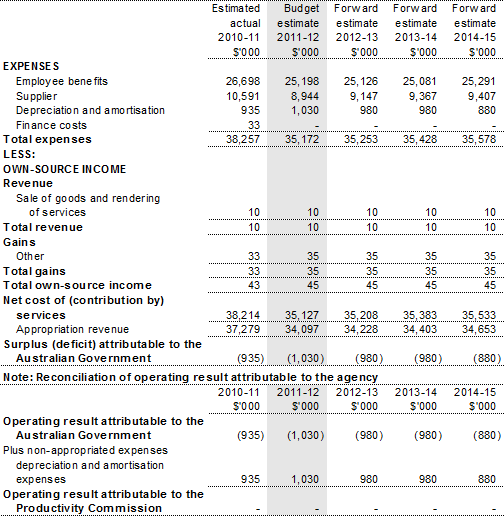
Prepared on Australian Accounting Standards basis.
Table 3.2.2: Budgeted departmental balance sheet
(as at 30 June)
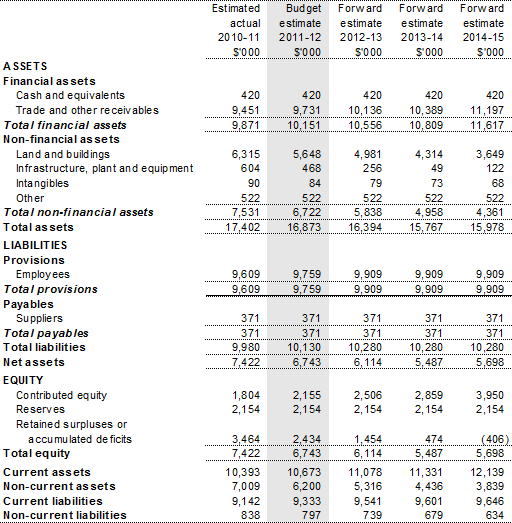
Prepared on Australian Accounting Standards basis.
Table 3.2.3: Budgeted departmental statement of cash flows
(for the period ended 30 June)
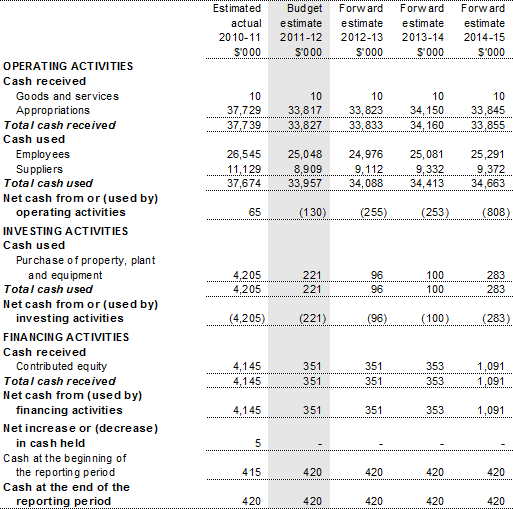
Prepared on Australian Accounting Standards basis.
Table 3.2.4: Departmental statement of changes in equity — summary of
movement (budget year 2011-12)
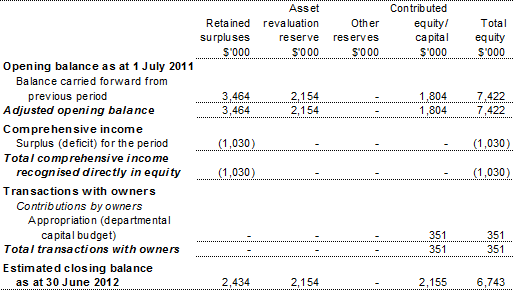
Prepared on Australian Accounting Standards basis.
Table 3.2.5: Departmental capital budget (DCB) statement
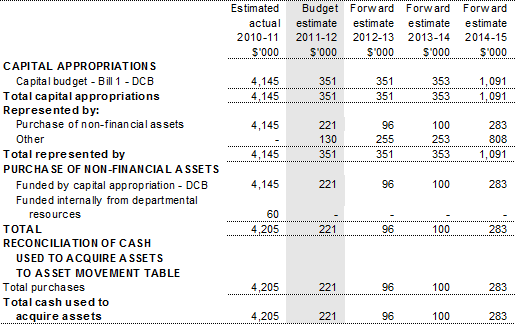
Prepared on Australian Accounting Standards basis.
Table 3.2.6: Statement of asset movements — departmental
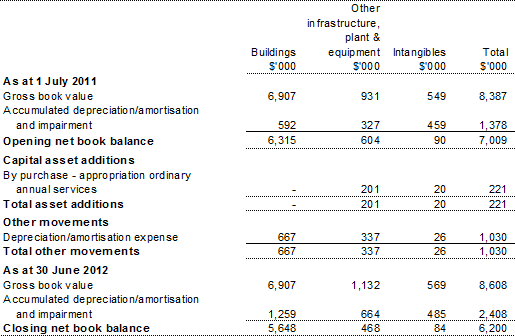
Prepared on Australian Accounting Standards basis.
3.2.4 Notes to the financial statements
The budgeted financial statements have been prepared on an Australian Accounting Standards Basis.